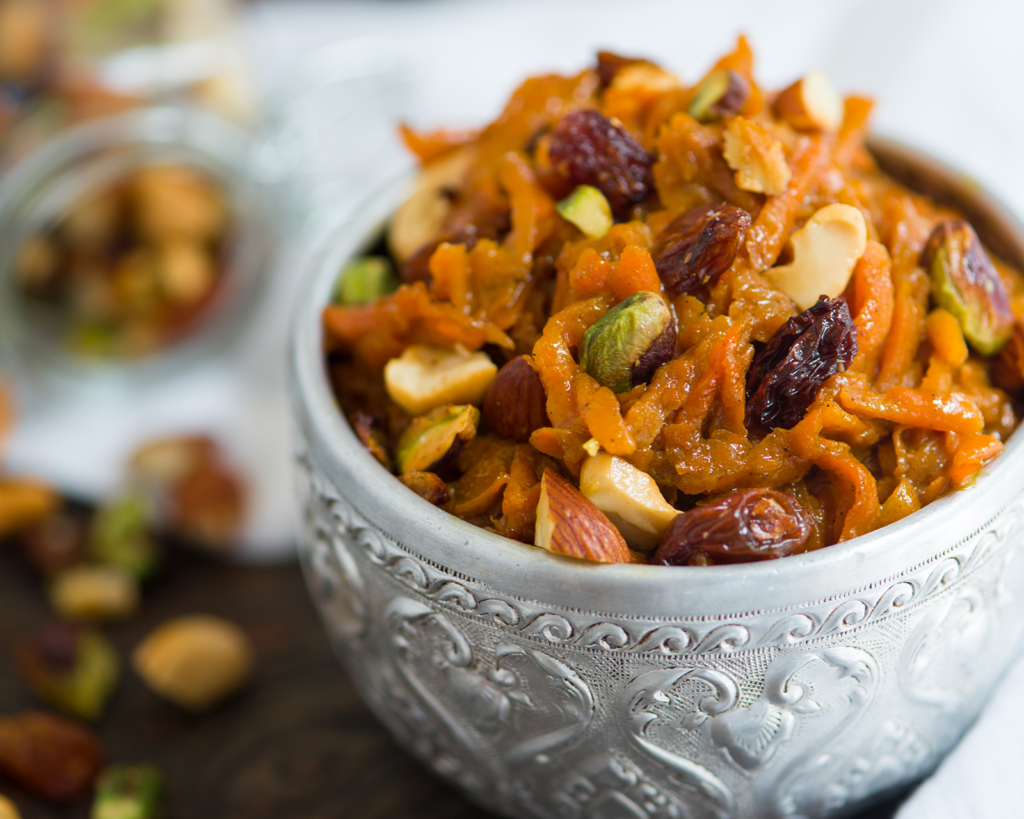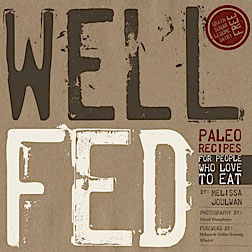In each issue of Paleo Magazine, I team up with Steph Gaudreau to share the history of a traditional recipe and adapt it to fit into a healthier paleo...
Read MorePunjabi-Style Carrot Pudding
In each issue of Paleo Magazine, I team up with Steph Gaudreau to share the history of a traditional recipe and adapt it to fit into a healthier paleo lifestyle. (I write the words; she makes the gorgeous photos.) In this column, we’re heading to northern India for a sweet treat made with the friendliest of vegetables.

A Carrot of a Different Color
Northern India’s Punjab region is known as “India’s bread-basket,” and it’s bordered by Pakistan and the western reach of the Himalayas. Thanks to its unique geography, it’s one of the most fertile regions on the planet, producing vast amounts of wheat, rice, potatoes, cotton, and sugarcane.
In addition to its rich, buttery flavors and beloved basmati rice, Punjabi cuisine is probably most notable in the rest of the world for its tandoori tradition: meat marinated and cooked in a specialized oven called a tandoor, where the temperature can reach up to 900 degrees Fahrenheit. And in a country renowned for its sweets—sugary dumplings, lush puddings, silver-topped pastries, golden-fried balls of dough—the dish known as gajar ka halwa is a Punjabi stand-out. Flecked with toasted nuts and seasoned with aromatic cardamom and rose water, it’s a pudding—with a surprising ingredient—that’s shockingly luscious.
It’s hard to believe this delicate dessert begins with the story of a humble root vegetable: the carrot.
In the sixteenth and seventeenth centuries, the Mughal Empire was expanding across the Indian continent and international traders followed with enticing, never-before-seen products, including the orange carrot. Carrots were originally purple (and red, yellow, or white) and had been grown in nearby Afghanistan for almost 5000 years. But in the 1600s, Dutch horticulturists developed an orange carrot. There’s some disagreement whether this beta-carotene powerhouse was created in a deliberate homage to the Dutch prince William of Orange—or whether it was merely the happy accident of the mutation of red and yellow varieties. Whatever the genesis, this new, orange carrot was wildly popular. It was sweeter, prettier, and less sticky, all of which made it irresistible to chefs eager to develop modern recipes.
In Punjab, cooks began to use the carrot in both sweet and savory dishes. It was finally transformed into gajar ka halwa, a dessert that could be enjoyed hot or cold and was at peak flavor just in time for Hindu festivals including the “festival of light” (Diwali), the “festival of colors” (Holi), and the sugar feast known as Eid al-Fitr.
The traditional recipe is prepared by simmering grated carrot with khoya (a fresh Indian cheese that’s similar to ricotta), milk, and sugar. When the carrots are soft, cashews are gently stirred into the pudding, along with more ghee, and it’s garnished with almonds and pistachios. A popular modern variation adds shredded papaya to the carrots for a fruity twist, and some cooks use equal amounts of carrots and red beets for even more vegetable power in their sweet treat.
This recipe replaces the traditional khoya and milk with coconut milk for plenty of creaminess without the dairy. We’ve kept the ghee for a buttery, nutty flavor, but if you prefer to completely eliminate all dairy, you may use coconut oil instead. The perfume of cardamom is essential to the flavor, but we’ve replaced the original rose water with vanilla extract, since it’s probably already in your pantry. If you want to try the more authentic version, replace the vanilla with an equal amount of rose water. And finally, our pudding is studded with a confetti of raisins, cashews, almonds, and pistachios to make any meal feel like a celebratory feast. If you want to try either the papaya or beet versions, replace two of the carrots in the recipe with 1 cup of shredded papaya or beets.
Paleo Punjabi-Style Carrot Pudding
Serves 4-6 | Prep 10 minutes | Cook 40 minutes
Ingredients:
1 tablespoon plus 1 teaspoon ghee
4 large carrots, coarsely grated
1 can unsweetened coconut milk
1/3 cup coconut sugar
1 1/2 teaspoons ground cardamom
1/2 teaspoon vanilla extract
pinch salt
2 tablespoons golden raisins
2 tablespoons chopped cashews
2 tablespoon chopped almonds
2 tablespoons chopped pistachios
Directions:
Melt 1 tablespoon ghee in a large nonstick skillet over medium-high heat; stir in the carrots and toss to coat; cook 1 minute. Add the coconut milk and bring to a boil. Reduce the heat to medium and simmer, stirring occasionally, until the carrots are very tender and the sauce is beginning to thicken, 10-15 minutes. Stir in the coconut sugar, cardamom, vanilla, and salt; cook 20 minutes, stirring occasionally. It should turn a caramel color and have the consistency of thick caramel.
Meanwhile, melt the remaining 1 teaspoon ghee in a small nonstick skillet over medium-high heat. Add the raisins, cashews, and almonds and sauté about 3-4 minutes, until the raisins are plump and the nuts are lightly toasted. Set aside to cool.
When the pudding is thickened, stir the nuts and raisins into the pudding and transfer to individual serving dishes. Refrigerate until set, then bring to room temperature to serve. Garnish with chopped pistachios just before eating.
For more delicious recipes like this one, subscribe to Paleo Magazine.
Still hungry? Try these
In each issue of Paleo Magazine, I team up with Steph Gaudreau to share the history of a traditional recipe and adapt it to fit into a healthier paleo...
Read More




I know it’s not authentic, but I’m wonder if this could be made in the Instant Pot? I’ll try it and let you know.
I am firmly of the opinion that no recipe is really “authentic,” because each cook makes it his or her own way. My great-grandmother’s hummus was authentic to her, but her recipe is different than many others I’ve seen. You can make this carrot pudding YOUR way 🙂
I made this today . It was not pretty at all like your picture but it was yummy. Mine was a little runny ;maybe I’ll add more carrots next time. By “grated carrots “ you mean shredded with a cheese grater, right?
update: mine firmed up after being in the fridge overnight and for the record it’s an equally yummy treat warm OR cold 🙂
I am Indian, and I certify that this is the authentic way of making it. Of couse since it’s paleo, you will substitute coconut milk for whole milk and coconut sugar for refined sugar.
Now as Mel said, no recipe is truly authentic as every household has a different way of making it. Also, if you ask any Punjabi grandmother the recipe for her carrot halwa, she won’t give you spoon or cup measurements, you know it in your heart the correct amount of ingredients 😀
Personally, I do put a lot more ghee into it 😉
Eat it while it’s still warm and it’s a great comfort food for a cold winter day 🙂
Ah, this is great! I’m glad to know I got close to the “real” way of making this delicious treat! Thank you so much for chiming in.
My great-grandmother taught my mom how to make all of our traditional Lebanese recipes, and there were no exact measurements there, either: a handful of such-and-such, water in the pan up to your thumbnail… that kind of cooking is so lovely.
I made it without the sugar for a breakfast during my Whole 30. It was sweet enough with just the carrots and comforting on a chilly winter morning. Delicious. I never would have enjoyed my Whole 30 so much without your cookbooks! Thank you.
Awesome! Good to know it works without the sugar, too. Thanks for letting us know!
Do you think this could be made with maple syrup, Mel?
Absolutely, and it will be delicious.
Yay! Thank you!❤